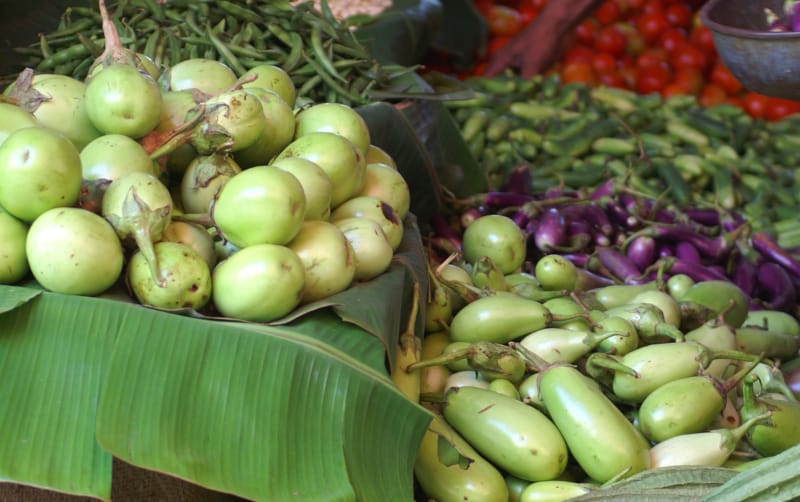Gutti vankaya kura every single day

After కూపస్థ మండూకం or బావిలో కప్ప (Kupastha Mandukam or baavilo kappa) found an ocean in గుంతకల్లు (Guntakallu or Guntakal) and thought it was time to explore the mighty ocean diving to new depths and enjoying the experiences it has to offer, it was time to move. Walking in the footsteps of mighty kings was interrupted for the time being. I remember coming home from school one day towards the end of August to the unpleasant news of moving again in less than two years. I barely started 9th grade where I knew the teachers and I had good friends. I wasn’t happy about the prospect of moving again and starting out yet again at a new school in a new place and making new friends.
By the time I heard the news about our impending move, the fun filled summer of visiting my cousins in అనంతపూర్ (Anantapur) was barely behind me. The summer went by fast with learning to swim and failing at it in a large rectangular చెరువు (cheruvu is tank or pond in Telugu) on my aunt’s farm in the outskirts of అనంతపూర్ (Anantapur). చెరువు (cheruvu) is much larger than a బావి (baavi is a well in Telugu) and could have a rectangular or irregular shape to hold large quantities of water for drinking, household use, and farming. The చెరువు (cheruvu) on my aunt’s farm was rather large and deep. We could get down into the water using ladders and then splash around in the cool water with old tires around our waists for flotation. It was a sight to see, when all of us kids were tubing down in the tank screaming and splashing water at each other.
The water from this చెరువు (cheruvu) fed the farm growing rice, grapes, and other vegetables. My aunt also had buffaloes and chickens. My aunt and my cousin still live on this farm and they now have peacocks. We ran around playing all day long on the farm picking grapes from the grapevines and sheltering under their shade during the afternoons. Bunches of small green seedless grapes were beautiful, delicious, and sweet. We came back to the farmhouse full of adults only when summoned for breakfast, lunch, and dinner.
నాన్న (Nanna is father in Telugu) would be chatting with his sisters and brothers-in-law. They were a food loving and fun loving bunch. There was a lot of food to go around while they engaged in teasing, and joking around. Adults would play Rummy, a card game popular in our family. On most afternoons, adults would be playing in one corner and all the kids playing in another corner in the hall. Hall was the word we used for a very large living room and family room rolled into one.
Carrom was the other game of choice. Carrom is a game of Indian origin in which players flick discs with two fingers, the pointing finger and the middle one, attempting to knock the discs into the small holes called pockets in the four corners of the board. Each player selects either beige or black disks and there is a special red disc which carries more points. A striker disc is flicked directing it to strike and pocket the discs. Each player attempts to pocket their discs taking turns and the first player who pockets all their discs wins that round. Pocketing the red disc is very rewarding as it carries double the points than pocketing the regular discs. Both of these games offered entertainment for players and onlookers alike and they went on all day long. These two games dominated our summer vacations at our grandparents’ place and whenever we got together at our aunts’ places.
Carrom could be played by two or four players at a time and there was no limit on countless onlookers cheering on their side. Both sides accused opponents of making noise while their side was getting ready to strike to distract them. Theories were floated that opponents were employing their crossing fingers magic, while the other side was just about to strike. Players would kiss the striker before placing it on the board to ward off opponents' evil magic. The whole house reverberated with conversations, cheers and screams when one side lost or won. The floor was covered with boric acid carrom powder which was sprinkled generously to smooth the Carrom board surface in between rounds. The boric acid powder tastes acidic and sour and you don’t want to slip on the floor covered with boric acid powder for sure. In the afternoon unlimited supply of chai and snacks would add to the fun.
నాన్న (Nanna)’s siblings were spread out living in various towns in Andhra Pradesh. All eight of them and their families got together in summer at our grandparents’ place. They visited each other during the year when they got a chance. I looked forward to going to visit our grandparents and aunts traveling in trains or buses. We traveled by train from గుంతకల్లు (Guntakallu) to అనంతపూర్ (Anantapur) to my aunt’s place. It was a short train ride and the train we rode in was a commuter train for college students who rode it everyday from గుంతకల్లు (Guntakallu) to attend colleges in అనంతపూర్ (Anantapur). I was just about eleven or twelve years of age then looking at the college students and their big books admiringly hoping to be like them in the future. I remember this one student who was buried in the books doing homework on a moving train and looking up to scan the other passengers once in a while.
Kalluru Junction station, along the way was famous for its పకోడ or పకోరా (pakoda or pakora). Describing it as deep fried dough doesn’t do justice to this afternoon snack that is served with piping hot delicious chai. When trains stopped at this station, పకోడ (pakoda) vendor would dispatch one of his employees to hand deliver a free packet of piping hot పకోడ (pakoda) to the Railway guard who rides in the very last compartment of the train. Trains don’t depart stations until the guards wave their green flag. The employee who had a bum leg would walk slowly to the other end of the platform to deliver the పకోడ (pakoda). The train would not leave until the guard got his share of the పకోడ (pakoda).
While the పకోడ (pakoda) packet was in transit, the vendor would send other employees to sell to passengers on the train. They would walk up and down the platform selling పకోడ (pakoda) packets. The transactions were rather quick as the passengers would be ready with their cash to buy పకోడ (pakoda) packets. These conical shaped packets were made out of old newspapers. Chai vendors were right behind the పకోడ (pakoda) vendors dispensing hot tea into glass tumblers to be collected later. Vendors would board the train to collect dirty tumblers and get off at the next station to catch the train going in the oher direction to make their way back to their station. This was before the prevalence of paper cups and now they use paper cups.
నాన్న (Nanna) would joke about how sending a guy with bum leg to deliver పకోడ (pakoda) to the gaurd was a very well thought out plan to get more time to sell పకోడ (pakoda) to passengers. I was more interested in watching the drama unfold than eating పకోడ (pakoda). నాన్న (Nanna) thought that the పకోడ (pakoda) was salty and his theory was that it was also a well thought out plan to increase the sales of నిమ్మకాయ రసం (Nimmakaaya rasam) or निम्बू पानी (neembu paani), గోలీ సోడా (Goli soda) and other soft drinks. గోలీ సోడా (Goli soda) is a popular carbonated soft drink sold in India. It is bottled in a distinctly shaped iconic marble bottle. A glass marble locked into a rubber gasket at the neck of the bottle seals the pressure of the carbonated drink. It was fun to watch the vendor opening the bottle by pressing on the marble to release the pressurized gas. Ramune is the Japanese version of గోలీ సోడా (Goli soda), one can enjoy in the USA. The marbles were great for playing games and we used to collect them.
నాన్న (Nanna) had a very important to reason to express his dislike for పకోడ (pakoda) as he was married to the queen of పకోడ (pakoda). అమ్మ (Amma is mother in Telugu) makes delicious పకోడ (pakoda) with శనగపిండి (senagapindi Gram flour in Telugu) and మైదా (maidaa), which is a super refined wheat flour. She mixes శనగపిండి (senagapindi) with diced onion, green chillies, and water and then drops small portions of the dough into hot oil and fries them until they are golden brown melt in the mouth perfection. She mixes మైదా (maidaa), a small quality of rice flour for crispiness, butter milk, and water to make the dough for మైదా (maidaa) పకోడ (pakoda). She makes బంగాళాదుంప బజ్జి (bangaladumpa is potato bajji in Telugu) and మిరపకాయ (mirapakaaya is green chilli in Telugu) bajji. Thinly sliced potatoes are dipped in శనగపిండి (senagapindi) batter and deep fried. She would make a small slit lengthwise in the green chilli and stuff it with her secret mix of spices before dipping in batter and deep frying them. Her మిరపకాయ (mirapakaaya) bajji was mouth watering and spicy hot. I would reach for more with tears streaming down my cheeks and sweat beading on my forehead. She would experiment with variations such as boiled egg bajji. She would dip thinly sliced boiled eggs in batter and deep fry them. Especially after నాన్న (Nanna) brought her a egg slicer, we ate a few too many servings of egg bajji. There was no chance of his survival if నాన్న (Nanna) were to say, he liked the పకోడ (pakoda) made by the vendor at the train station.

I was very sad when I heard about leaving గుంతకల్లు (Guntakallu) behind to move to a smaller place. We packed our things and made our way back to our new home after a fabulous and a very short stay in one of my favorite places and phases of my life. The excitement I felt on our journey to గుంతకల్లు (Guntakallu) just a year and half ago was replaced by sadness and longing. నాన్న (Nanna) made a tough decision to move back to his old position to serve in villages as a veterinary doctor for job stability when he was asked to choose between the veterinary and poultry marketing divisions. His decision paid off for the family in the long run and still paying as అమ్మ (Amma) is receiving family pension even to this day.
We moved into a temporary housing while we waited for a permanent house closer to నాన్న (Nanna)’s hospital to become vacant. We didn’t unpack fully since we would have to move in a month or two. We stacked all our trunks, suitcases, and other luggage in one room. We would take clean clothes out of trunks and put washed clothes back in them every single day living out of the boxes. అమ్మ (Amma) packed all the spices in a large trunk for the move. She didn’t want to unpack the spices. She would take spices out of the large trunk for each meal and put them back. She would be in the middle of cooking and yell out loud for me to go get species from the trunk.
We moved back to Coastal Andhra region after having lived in Rayalaseema for two years. I loved a lot of things in Rayalaseema, however I missed వంకాయ (vankaaya is aubergine or eggplant in Telugu). Vegetables in Rayalaseema were different especially వంకాయ (vankaaya). I love anything made with వంకాయ (vankaaya), especially the గుత్తి వంకాయ కూర (Gutti vankaya kuura), a dish made out of వంకాయ (vankaaya) sliced with its stem intact into a flower shape, stuffed with delicious marinade and pan fried. గుత్తి (gutti) means bunch in Telugu, hence this dish is called గుత్తి వంకాయ కూర (Gutti vankaya kuura). అమ్మ (Amma)’s గుత్తి వంకాయ కూర (Gutti vankaya kuura) was to die for. అమ్మ (Amma)’s recipe is different from all other recipes of this dish. She used శనగపప్పు (sanagapappu is chana dal in Telugu) instead of peanuts.
The one silver lining in this unpleasantness of moving was tender వంకాయ (vankaaya) and delicious గుత్తి వంకాయ కూర (Gutti vankaya kuura). I asked అమ్మ (Amma) to make it every single day for several weeks until the rest of the family revolted for reasons I couldn’t fathom. I remember bringing మెంతి గింజలు (methi ginjalu is fenugreek seeds in Telugu) from the spice trunk to make the marinade. When I think of గుత్తి వంకాయ కూర (Gutti vankaya kuura), I remember the strong aroma of spices wafting out of the trunk when I opened it to find the bitter మెంతి గింజలు (methi ginjalu) to make the melt in the mouth గుత్తి వంకాయ కూర (Gutti vankaya kuura). As time went by the sadness dissipated as I settled into a routine making new friends at school and started to enjoy the new sights and scenes the new place had to offer. Eating గుత్తి వంకాయ కూర (Gutti vankaya kuura) did wonders to promote a quick recovery.

